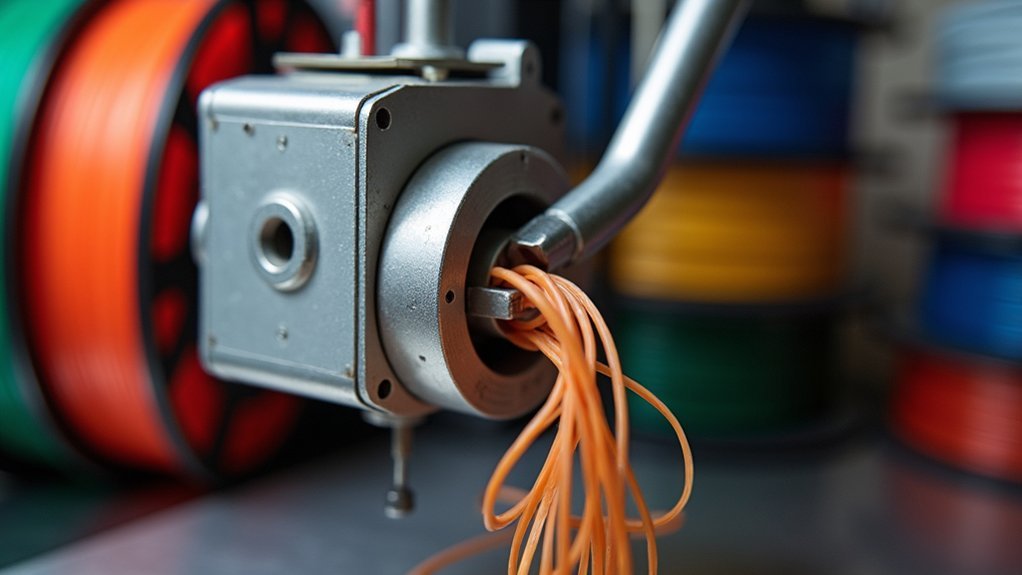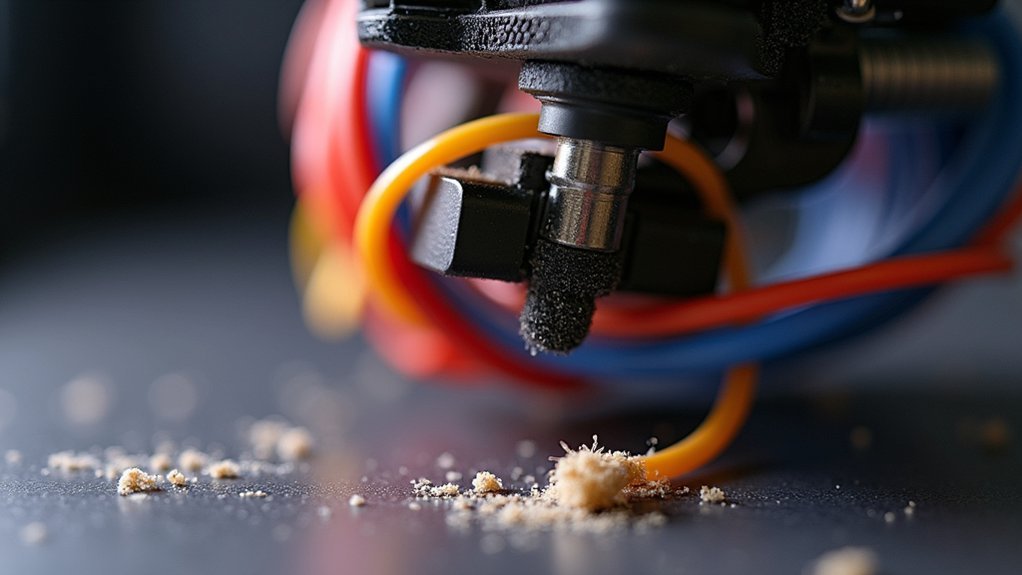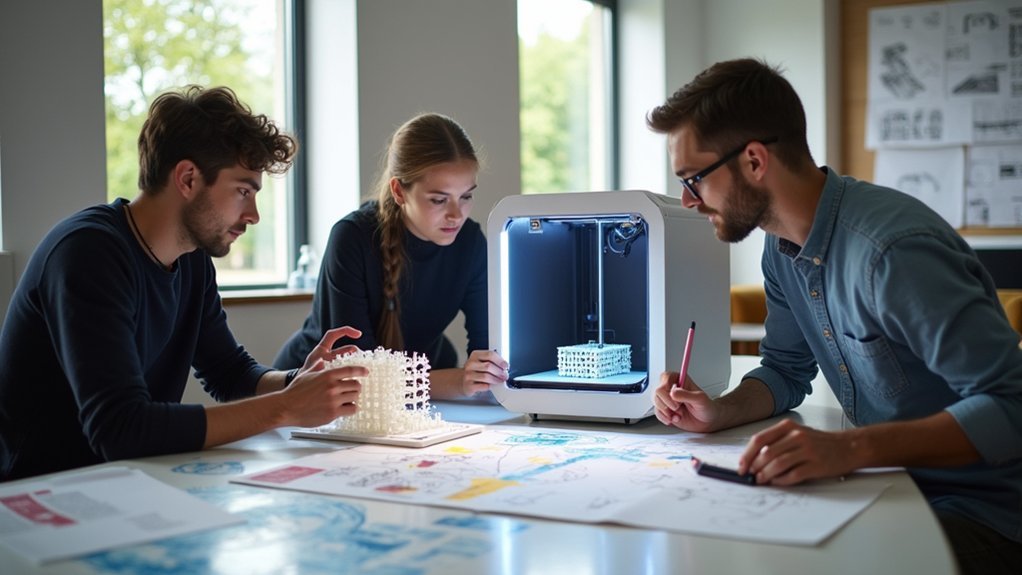You’ll encounter seven main Bowden tube extruder feeding problems: motor clicking from excessive resistance or damaged cables, tube blockages from debris accumulation, gaps between the tube and nozzle due to heat degradation, filament tangling in sharp bends, clogged nozzles from poor maintenance, erratic motor behavior from loose connections, and inconsistent extrusion caused by low-quality filament. Each issue creates unique symptoms that’ll disrupt your prints, but understanding their root causes and implementing proper maintenance routines will transform your printing experience from frustrating failures to reliable results.
Extruder Motor Clicking and Skipping Steps

When your extruder motor starts clicking and skipping steps, it’s signaling that the stepper motor can’t overcome the resistance needed to push filament through the system. This clicking noise typically indicates excessive filament push force requiring idler pressure adjustments.
First, inspect your filament for deformation. Crushed filament means you’ll need to decrease idler pressure, while gouged filament might require increased pressure—but don’t over-tighten.
Check your retraction settings too, as high values can worsen clicking sounds.
Examine your Bowden tube’s PTFE liner for wear and guarantee smooth filament feeding throughout the path. Friction anywhere from extruder motor to hotend creates resistance.
Monitor your extruder during printing to catch clicking early, allowing timely adjustments that maintain consistent extrusion performance.
Bowden Tube Blockages and Friction Issues
You’ll encounter blockages when debris accumulates inside your Bowden tube, creating obstructions that restrict filament flow and cause extrusion failures.
The tube’s interior surface wears down over time, increasing friction that prevents smooth filament movement and leads to inconsistent printing results.
Your tube’s bend radius and overall length directly impact resistance levels, so excessive curves or unnecessary length will create feeding problems that require immediate attention.
Debris Obstruction Solutions
Several common debris-related issues can plague your Bowden tube system and greatly impact print quality.
You’ll need to address these problems systematically to restore proper filament flow and prevent future printing failures.
When tackling debris obstructions, focus on these key solutions:
- Regular tube inspections – Remove the tube from both ends and visually examine the interior for accumulated particles, dust, or filament fragments that restrict flow.
- Thorough cleaning procedures – Use compressed air or a cleaning filament to push debris through the tube, then wipe the interior with a soft cloth.
- Proper hot end maintenance – Check to make sure your hot end connection remains secure, as this common problem often allows debris to enter the system.
Replace worn tubes immediately when cleaning doesn’t restore smooth operation.
Worn Interior Friction
Beyond debris accumulation, the Bowden tube’s interior surface itself can deteriorate over time, creating friction that impedes smooth filament movement.
When you’re trying to print, worn tube interiors cause filament to move back and forth inconsistently, resulting in poor extrusion quality and failed prints.
The degraded inner surface increases resistance as filament travels through the tube, making your extruder work harder.
High bend radii worsen this friction, so maintaining straighter tube paths helps reduce stress on the system.
You should regularly inspect your Bowden tube’s interior for wear signs or damage.
Look for rough surfaces, scratches, or discoloration that indicate deterioration.
Replacing worn tubes greatly improves extrusion reliability and eliminates the friction that causes feeding problems during printing operations.
Bend Radius Problems
Sharp bends in your Bowden tube create bottlenecks that drastically increase friction and block filament flow during printing.
These restrictions force your extruder motor to work harder, leading to inconsistent extrusion and potential feeding failures that ruin your prints.
To minimize bend radius problems, focus on these key areas:
- Route positioning – Keep your Bowden tube as straight as possible between the extruder and hotend, avoiding unnecessary curves or loops.
- Mounting adjustments – Reposition your extruder or filament spool to reduce the required tube length and eliminate sharp angles.
- Tube replacement – Install a longer Bowden tube if your current setup forces excessive bending or kinking.
Proper tube routing guarantees smooth filament movement, reduces extruder strain, and maintains consistent print quality throughout your projects.
Gap Between Bowden Tube and Nozzle
You’ll encounter gaps between your Bowden tube and nozzle when heat degradation weakens the tube’s end or when aggressive retractions pull it away from the hotend.
This separation creates a dead space where filament can accumulate and degrade, leading to inconsistent extrusion and poor print quality.
The problem worsens as repeated heating cycles soften the PTFE tube material while retraction movements gradually work the tube loose from its secure position.
Heat Degradation Causes
When exposed to continuous high temperatures, your Bowden tube’s PTFE material gradually breaks down and creates a gap between the tube and nozzle that’ll cause serious extrusion issues.
The degradation process happens because PTFE isn’t designed to withstand prolonged exposure to the elevated temperatures found in your hot end. As the material deteriorates, it loses its structural integrity and can’t maintain the tight seal necessary for proper filament flow.
Several factors accelerate this heat degradation:
- Repeated thermal cycling from heating and cooling cycles weakens the PTFE structure over time
- Excessive printing temperatures beyond the tube’s recommended range cause faster material breakdown
- Poor ventilation around the hot end traps heat and intensifies degradation
This degradation creates under-extrusion, weak layer adhesion, and inconsistent print quality that’ll compromise your entire project.
Retraction Gap Formation
During retraction movements, your Bowden tube can pull away from the nozzle and create a problematic gap that disrupts filament flow.
This gap causes under-extrusion and weakens your prints, particularly along seams where retraction occurs most frequently. You’ll also notice excessive stringing since the nozzle can’t effectively pull back filament during retractions.
Key symptoms include difficulty unloading filament even after heating the nozzle and visible filament appearing outside the Bowden tube.
To fix this issue, you’ll need to remove the nozzle and inspect for excess filament buildup. Verify your Bowden tube sits properly and securely in the hot end.
Regular maintenance focusing on the tight fit between tube and nozzle prevents gaps from forming and maintains consistent print quality.
Filament Getting Stuck or Tangled in the Feed Path

Although filament getting stuck or tangled in the feed path can bring your printing session to a frustrating halt, most of these issues stem from preventable setup and maintenance oversights.
Most filament feed problems that ruin prints come from simple setup mistakes you can easily avoid with proper preparation.
You’ll need to focus on several key areas to maintain smooth filament flow:
- Spool management – Mount your filament spool correctly so it rotates freely without binding or creating tangles during feeding.
- Bowden tube maintenance – Clean debris from inside the tube and check that it’s fully inserted into both the HotEnd and feeder connections without gaps.
- Path optimization – Minimize excessive bends in your Bowden tube by creating straighter routing or using a longer tube when necessary.
Regular monitoring helps you spot friction points early, including worn components or misalignments that could stop your filament mid-print.
Clogged Nozzle Preventing Proper Flow
A clogged nozzle ranks among the most disruptive issues you’ll encounter with Bowden tube extruders, as it directly blocks the final stage where molten filament should flow smoothly onto your print bed. When clogs develop, you’ll notice under-extrusion, gaps in layers, and overall poor print quality.
| Common Causes | Symptoms | Solutions |
|---|---|---|
| Incorrect temperature | Under-extrusion | Adjust hotend temp |
| Over-tightened nozzle | No filament flow | Proper nozzle seating |
| Excessive retraction | Intermittent flow | Reduce retraction distance |
| Poor maintenance | Layer adhesion issues | Regular nozzle cleaning |
| Filament contamination | Inconsistent extrusion | Use quality filament |
Temperature problems cause filament to solidify inside the nozzle, while excessive retraction pulls material back too far. Regular cleaning prevents most clogs from developing.
Motor Cable Problems Causing Erratic Behavior

While nozzle clogs block material flow at the hotend, electrical issues further up the chain can create equally frustrating problems. Your extruder motor’s cable connections directly impact performance, and even minor issues can cause significant headaches.
Motor cable problems manifest in several ways:
- Loose connections create inconsistent power delivery, causing your stepper motor to skip steps or stall mid-print.
- Damaged wires disrupt electrical signals, leading to unpredictable motor behavior that’ll ruin your print quality.
- Swapped leads misdirect control signals, making your extruder move erratically or in the wrong direction.
You’ll also risk damaging your driver chip if broken wires create voltage spikes.
Regular inspection of your motor cables prevents these issues from disrupting your extrusion process and saves you from costly repairs.
Inconsistent Extrusion Due to Poor Filament Quality
Even when your extruder motor runs perfectly, poor filament quality can sabotage your prints through inconsistent extrusion.
Low-quality filament often has inconsistent diameter variations that force your extruder to struggle with feeding, resulting in under-extrusion and print failures. These filaments contain additives that break down during printing, causing clogs and variable output.
Poor filament quality with inconsistent diameter forces your extruder to struggle, causing under-extrusion and print failures through variable output.
Moisture absorption presents another major issue, particularly with PLA filament.
When filament absorbs moisture over time, it greatly impacts performance and creates inconsistent extrusion patterns. The degraded material can break down mid-print, leading to feeding problems and ruined prints.
You’ll achieve remarkably better results by investing in high-quality, unopened filament.
Consistent diameter specifications and proper storage guarantee reliable extrusion and eliminate many common Bowden tube feeding issues.
Frequently Asked Questions
Why Is My Extruder Skipping Randomly?
Your extruder’s skipping randomly because you’ve got excessive idler pressure crushing filament, high retraction settings causing resistance, or friction from worn PTFE liner and debris blocking smooth filament flow through your system.
Why Does My Bowden Tube Keep Getting Pushed Out?
Your Bowden tube’s getting pushed out because there’s a gap between the tube and nozzle, or your retaining clip’s loose. High retraction settings and heat degradation worsen this issue.
Why Is My Extruder Not Extruding Properly?
Your extruder isn’t extruding properly because you’ve got a clogged nozzle, worn Bowden tube, incorrect nozzle height, tangled filament, or wrong extruder settings like retraction distance and speed.
How to Tell if a Bowden Tube Is Bad?
You’ll notice a bad Bowden tube if there’s visible wear inside, debris blocking filament flow, gaps causing leaks, sharp kinks restricting movement, or consistent filament jams during printing.





Leave a Reply